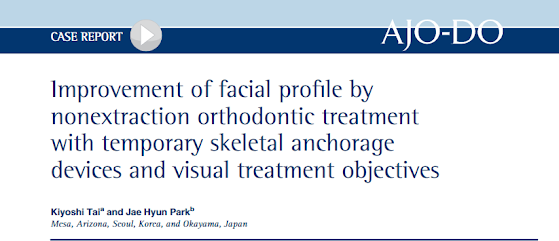Improvement of facial profile by nonextraction orthodontic treatment with temporary skeletal anchorage devices and visual treatment objectives (summary )
- Get link
- X
- Other Apps
if you are intersted in this article please follow for more readings
https://myorthodonticsblogg.blogspot.com/ 👈🏻
This article discusses a case report of a 15-year-old girl with a convex profile and retrognathic chin who underwent non-extraction orthodontic treatment using temporary skeletal anchorage devices (TSADs) and visual treatment objectives (VTOs).
The treatment plan was presented to the patient and her parents using computer-generated VTOs, which allowed them to visualize the expected outcome of the treatment. The treatment objectives were achieved, and the patient's facial profile and occlusion were significantly improved.
The post-treatment records showed acceptable root parallelism, and there were no significant signs of bone or root resorption. The patient had a stable occlusion at the 12-month retention examination. The article highlights the use of TSADs in orthodontic treatment, which has become increasingly popular in recent years. These devices allow for precise control of tooth movement and can be used to achieve a wide range of treatment objectives.
In this case, TSADs were used to intrude the maxillary posterior teeth, which helped to correct the patient's convex profile and retrognathic chin.
The use of TSADs also allowed for the distalization of the mandibular dentition, which helped to improve the patient's occlusion. The article also discusses the use of computer-generated VTOs in orthodontic treatment planning. These VTOs allow patients and their parents to visualize the expected outcome of the treatment, which can help to improve patient satisfaction and compliance. In this case, the use of VTOs helped to ensure that the treatment objectives were clearly communicated to the patient and her parents.
The article also discusses the concept of lip strain, which refers to the amount of tension that is placed on the lips during orthodontic treatment. Lip strain can be a concern in patients with convex profiles, as excessive tension on the lips can lead to lip incompetence and other soft tissue problems. The use of TSADs in this case helped to minimize lip strain by allowing for precise control of tooth movement.
The article emphasizes the importance of treatment planning in achieving successful orthodontic outcomes. The use of TSADs and VTOs allowed for precise control of tooth movement and helped to ensure that the treatment objectives were clearly communicated to the patient and her parents. The post-treatment records showed acceptable root parallelism, and there were no significant signs of bone or root resorption. The patient had a stable occlusion at the 12-month retention examination.
In conclusion, this case report highlights the successful use of TSADs and VTOs in non-extraction orthodontic treatment. The use of TSADs allowed for precise control of tooth movement, while VTOs helped to ensure that treatment objectives were clearly communicated to the patient and her parents. The post-treatment records showed acceptable root parallelism and stable occlusion. The article also emphasizes the importance of treatment planning and the evaluation of lip strain in achieving successful orthodontic outcomes. Overall, this case report demonstrates the potential benefits of using TSADs and VTOs in orthodontic treatment planning and execution.
- Get link
- X
- Other Apps



Comments
Post a Comment